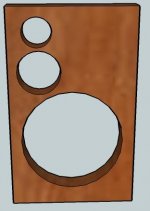Copy that Gainphile I lived and worked in Marysville for a while.
Big big shock and a lot of pain
BUT '
why don't people listen and take reasonable precautions, leave early or STAY!!!
i am so angry over this as well as sad
Regards
Ted
Big big shock and a lot of pain
BUT '
why don't people listen and take reasonable precautions, leave early or STAY!!!
i am so angry over this as well as sad
Regards
Ted
merajsalek said:
I'm trying to wrap my head around polar response at the moment. I'm a bit confused with Gainphile's advice to cross over to the tweeter at 1.5KHz to avoid OB peaks and dips. Wouldn't putting a inverted-phase tweeter at the rear cause those same peaks and dips?
😕
That is correct. But those peak and dips will start higher on tweeter's frequency because of tweeter's diameter << midrange diameter. For argument's sake using JohnK's simulator - P13WH mid and TC20 tweeters:
mid peak and dip starts at 1.5kHz
tweeter peak and dip starts at 2.5kHz
But yes, there will still be peak and dips, there is no way around this except changing baffle size towards the tweeter, or use waveguide etc (maybe..) but that's deviating from dipole radiation which we want.
SL also looked at this and argued that the directivity/beaming of the tweeters themselves is enough to give smooth polar response. I guess the only way to find out is to measure it. I may just go outside and do this later.
Both SL and JohnK do not advise equalizing dipole response of the tweeters.
The other motivation was I would like to operate P13WH at their pistonic state (1/2 wavelength), which incidentally also 1.5kHz. For B3N it could easily be 2 - 3 kHz.
That is correct. But those peak and dips will start higher on tweeter's frequency because of tweeter's diameter << midrange diameter. For argument's sake using JohnK's simulator - P13WH mid and TC20 tweeters: mid peak and dip starts at 1.5kHz tweeter peak and dip starts at 2.5kHz But yes, there will still be peak and dips, there is no way around this except changing baffle size towards the tweeter, or use waveguide etc (maybe..) but that's deviating from dipole radiation which we want. SL also looked at this and argued that the directivity/beaming of the tweeters themselves is enough to give smooth polar response.
Thanks for that mate! It makes sense now 🙂 I totally overlooked the driver dia.
The other motivation was I would like to operate P13WH at their pistonic state (1/2 wavelength), which incidentally also 1.5kHz. For B3N it could easily be 2 - 3 kHz.
In that case, I suppose a B2S 2" would be a better choice as a mid range, wouldn't it?
As it stands now, I'll use:
Front and reverse tweeters: Apex Jr. $1 (crossed over at 5KHz?)
Mid: HiVi B2S (crossed over at 1.5KHz)
Woofer: Jaycar Response 5.5" (crossed over at 120Hz)
Subwoofer: yet to be decided upon, should be a 8" or 10" Linkwitz transformed in a sealed box + plate amp or bridged GCs.
I would think B2S dont have excursion capability to cover 120Hz - 1.5kHz though?
This is the classic "you can't win all" situation ...
This is the classic "you can't win all" situation ...
Oh pardon me! I forgot to mention I'm already considering a 3-way!!
Or is it a 3.1
Front and reverse tweeters: Apex Jr. $1 (crossed over at 5KHz?)
Mid: HiVi B2S (crossed over at 1.5KHz)
Woofer: Jaycar Response 5.5" (crossed over at 120Hz)
Subwoofer: yet to be decided upon, should be a 8" or 10" Linkwitz transformed in a sealed box + plate amp or bridged GCs.
Or is it a 3.1

For easier understanding:
Front and reverse tweeters: Apex Jr. $1 - 5KHz-22KHz
Mid: HiVi B2S - 1.5KHz-5KHz
Woofer: Jaycar Response 5.5" - 120Hz-1.5KHz
Subwoofer: yet to be decided upon, should be a 8" or 10" Linkwitz transformed in a sealed box + plate amp or bridged GCs. - 120Hz-30Hz
Front and reverse tweeters: Apex Jr. $1 - 5KHz-22KHz
Mid: HiVi B2S - 1.5KHz-5KHz
Woofer: Jaycar Response 5.5" - 120Hz-1.5KHz
Subwoofer: yet to be decided upon, should be a 8" or 10" Linkwitz transformed in a sealed box + plate amp or bridged GCs. - 120Hz-30Hz
Oh, I see.. that makes more sense.
I tried to cross my P13 which is also a 5.25" midrange to 120Hz and was unsuccessful. The driver rolls off even if Fs is 60Hz. Plus it was quite strained. I am successful with 300Hz.
For 120Hz SL needed an 8" woofer, and Nao dual 6".
Would be keen to know the Jaycar woofer quality. Please report.
I tried to cross my P13 which is also a 5.25" midrange to 120Hz and was unsuccessful. The driver rolls off even if Fs is 60Hz. Plus it was quite strained. I am successful with 300Hz.
For 120Hz SL needed an 8" woofer, and Nao dual 6".
Would be keen to know the Jaycar woofer quality. Please report.
On paper the low end FR for the Jaycar looks almost identical to P13. I'm still hopeful - they might just pull it off nearfield... fingers crossed 

These just arrived.
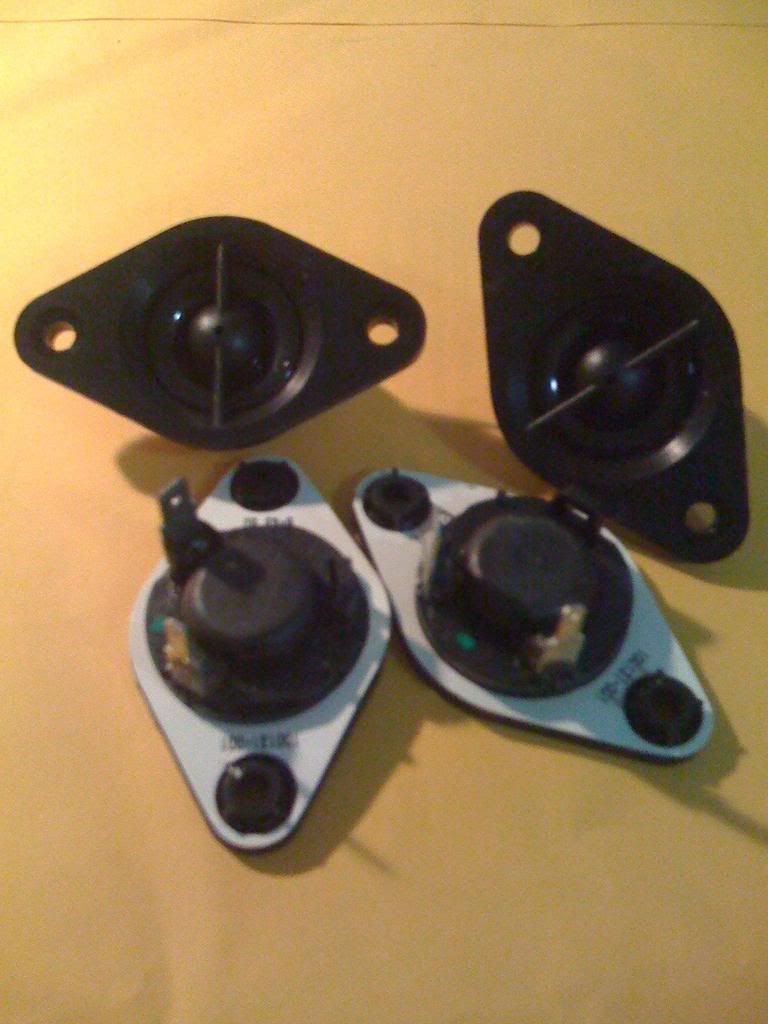
Brisso57 dropped 'em in my mailbox for next to nothing!! I'm one step closer to my Desktop OB.
I love the kind folks of this forum

Brisso57 dropped 'em in my mailbox for next to nothing!! I'm one step closer to my Desktop OB.
I love the kind folks of this forum

Hi folks,
Got a bit side-tracked on my project. Life got in the way
These just in:
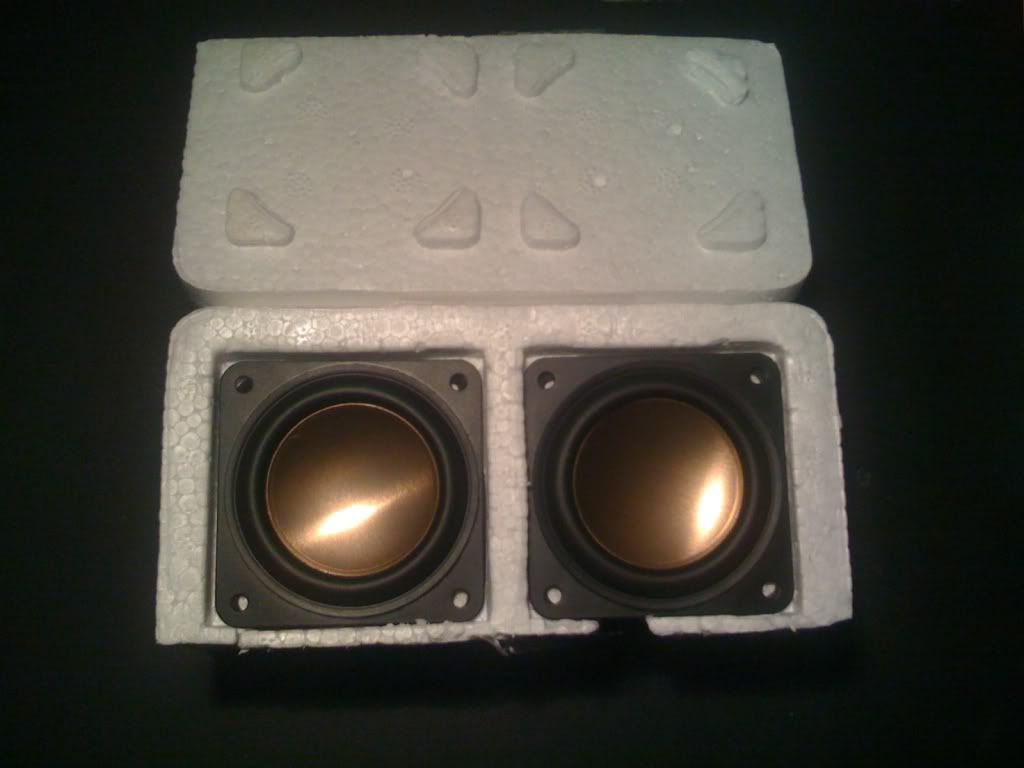
The system being built:
Front and reverse tweeters: Apex Jr. $1 - 5KHz-22KHz
Mid: HiVi B2S - 1.5KHz-5KHz
Woofer: Jaycar Response 5.5" - 120Hz-1.5KHz
Subwoofer: yet to be decided upon, should be a 8" or 10" Linkwitz transformed in a sealed box + plate amp or bridged GCs. - 120Hz-30Hz
The baffles I'm considering are:
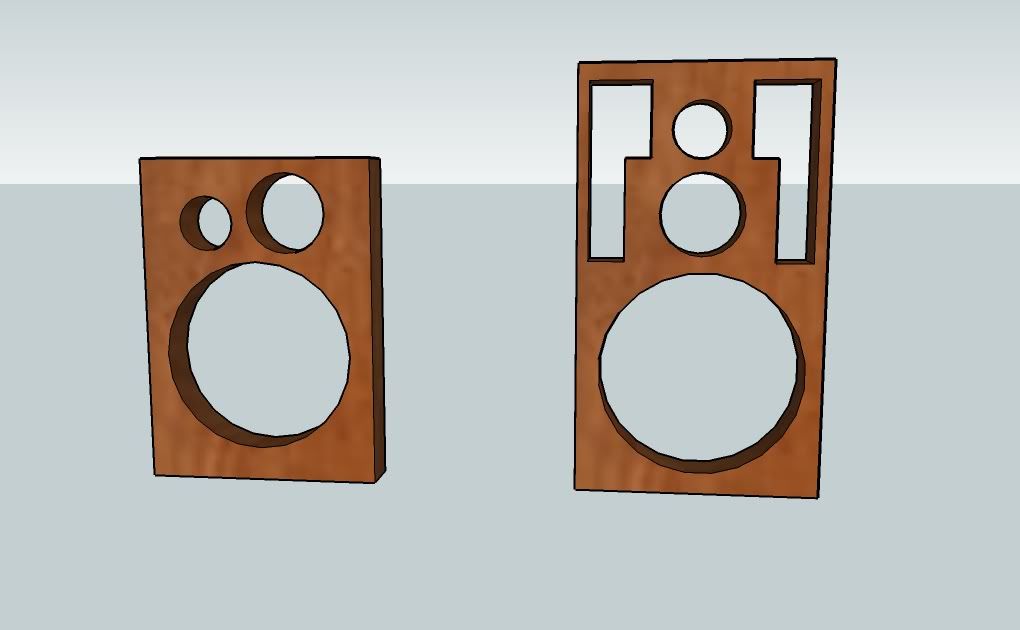
The one on left would save me some space, but the driver positioning would not conform to the OB rule of thumb of baffle = 2* cone dia. The one on the right conforms, but would be a bit larger.
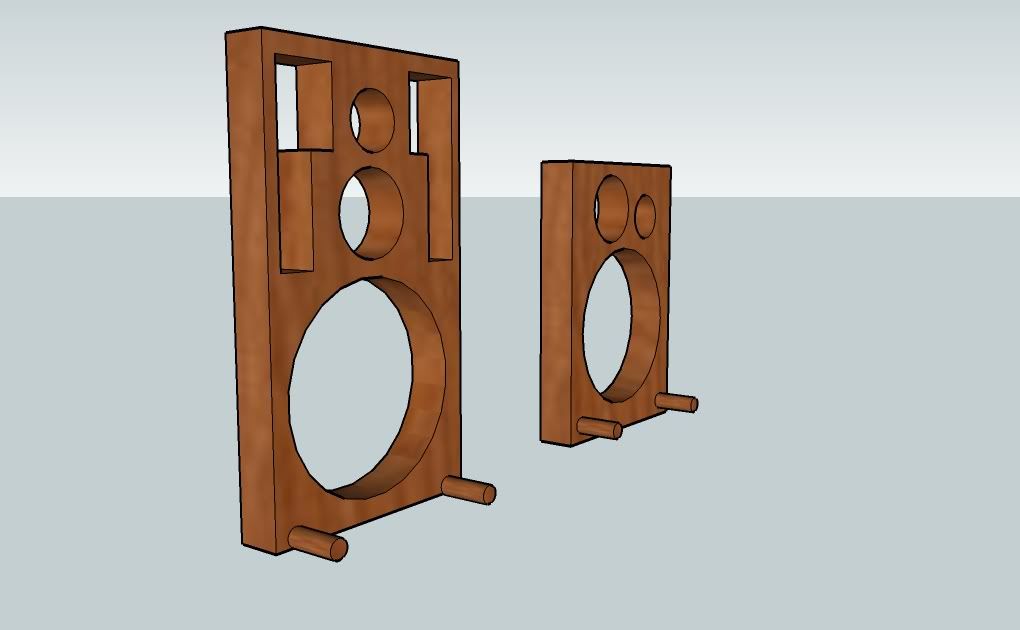
Comments please!!
Got a bit side-tracked on my project. Life got in the way

These just in:

The system being built:
Front and reverse tweeters: Apex Jr. $1 - 5KHz-22KHz
Mid: HiVi B2S - 1.5KHz-5KHz
Woofer: Jaycar Response 5.5" - 120Hz-1.5KHz
Subwoofer: yet to be decided upon, should be a 8" or 10" Linkwitz transformed in a sealed box + plate amp or bridged GCs. - 120Hz-30Hz
The baffles I'm considering are:

The one on left would save me some space, but the driver positioning would not conform to the OB rule of thumb of baffle = 2* cone dia. The one on the right conforms, but would be a bit larger.

Comments please!!
merajsalek,
in my opinion the left baffle is compromised because mid and tweeter are side by side - resulting in severe off-axis response dips in the x-over region.
The right baffle would not really conform to the baffle = 2* cone rule IMHO. The outer "framework" would allow some nice additional edge diffraction 😱
All in all I would question the rationale behind a 4way system for a desktop OB. But that´s just a personal view.
Rudolf
in my opinion the left baffle is compromised because mid and tweeter are side by side - resulting in severe off-axis response dips in the x-over region.
The right baffle would not really conform to the baffle = 2* cone rule IMHO. The outer "framework" would allow some nice additional edge diffraction 😱
All in all I would question the rationale behind a 4way system for a desktop OB. But that´s just a personal view.
Rudolf
Hi Rudolf,
Thank you for your comments. I'd put the frames because I want [read GAF] a rectangular speaker on the desk to complement the decor. I intend to cover the baffle permanently in grill cloth - a la Hawthorne solo/duet.
How about replacing the wooden frame with thin acrylic or metal tubing? My skills in Google Sketch is still sub-par, the floating tubes on the top are meant to be connected to the ones on the side...

The rational behind a 4-way Desktop OB was the size of my starving student wallet, the drivers I can afford pretty much decided it for me...
Thank you for your comments. I'd put the frames because I want [read GAF] a rectangular speaker on the desk to complement the decor. I intend to cover the baffle permanently in grill cloth - a la Hawthorne solo/duet.
How about replacing the wooden frame with thin acrylic or metal tubing? My skills in Google Sketch is still sub-par, the floating tubes on the top are meant to be connected to the ones on the side...

The rational behind a 4-way Desktop OB was the size of my starving student wallet, the drivers I can afford pretty much decided it for me...

Hey Andi,
Did a very rudimentary listening test on the B2S's. Hooked em up to a 1875 GC and had a listen.... I'm happy with the B2S's so far, Dido sounded nice 🙂
I have a feeling they'd do quite well in the range I have in mind (1.5KHz-5KHz).
I'll be building a mock-up baffle to see (hear) how the drivers sound together and maybe take some measurements as well....
Hope to report back soon
Did a very rudimentary listening test on the B2S's. Hooked em up to a 1875 GC and had a listen.... I'm happy with the B2S's so far, Dido sounded nice 🙂
I have a feeling they'd do quite well in the range I have in mind (1.5KHz-5KHz).
I'll be building a mock-up baffle to see (hear) how the drivers sound together and maybe take some measurements as well....
Hope to report back soon
This looks much more like what I would do. 🙂merajsalek said:
How about replacing the wooden frame with thin acrylic or metal tubing?
The rational behind a 4-way Desktop OB was the size of my starving student wallet, the drivers I can afford pretty much decided it for me...
Funny rationale behind that ... getting complicated because of shortage of funds. I will use that the next time my wife asks, why I can´t build speakers like anybody else does 😀
But joking apart - does one really have to follow the double cone diameter rule with a desktop speaker? You have got a fixed listening position in the nearfield with side wall reflections far away. You need only concern the front wall reflection IMHO, and that could be minimised by a proper toe-in of the baffles.
So I would use a full size baffle and push the drivers to the (inner) baffle edge until I get flat response on the listening axis.
merajsalek said:
I have a feeling they'd do quite well in the range I have in mind (1.5KHz-5KHz).
Thanks. I believe they would be perfect for that range, but I was thinking to use them as tweeters. Any chance trying it from 1.5kHz to 20kHz ? How the high will perform?
Sorry for the delay in my reply folks, was immersed in an assignment🙁
Rudolf:
I see your point, it is funny indeed... I had the following considerations in mind when I decided, do let me know if I went off course:
A. I want to operate all the drivers in their most linear range.
B. For my modest budget of around AU$50 per channel for drivers, I had access to a very limited range of drivers. A 2-way (which I was after in the 1st place) with the drivers I could get would push them out of the most linear part of their FR, hence the 3-way.
C. I would be going active for the XO (tri amp) and filters
D. The TIME factor! I fully expect to spend 6-7 months sourcing parts and building bit by bit. It's better than saving up for that long (i was never any good at it 🙄 ) and build all of it at a go.
you've lost me on that one! how can I go about achieving it?
how can I go about achieving it?
Gainphile:
I'll give the B2S a try in that range and let you know as soon as I can. Believe I can come back to you tomorrow...
Cheers
Rudolf:
Funny rationale behind that ... getting complicated because of shortage of funds.
I see your point, it is funny indeed... I had the following considerations in mind when I decided, do let me know if I went off course:
A. I want to operate all the drivers in their most linear range.
B. For my modest budget of around AU$50 per channel for drivers, I had access to a very limited range of drivers. A 2-way (which I was after in the 1st place) with the drivers I could get would push them out of the most linear part of their FR, hence the 3-way.
C. I would be going active for the XO (tri amp) and filters
D. The TIME factor! I fully expect to spend 6-7 months sourcing parts and building bit by bit. It's better than saving up for that long (i was never any good at it 🙄 ) and build all of it at a go.
You need only concern the front wall reflection IMHO, and that could be minimised by a proper toe-in of the baffles. So I would use a full size baffle and push the drivers to the (inner) baffle edge until I get flat response on the listening axis.
you've lost me on that one!
 how can I go about achieving it?
how can I go about achieving it?Gainphile:
I'll give the B2S a try in that range and let you know as soon as I can. Believe I can come back to you tomorrow...
Cheers
A. I want to operate all the drivers in their most linear range.
B. For my modest budget of around AU$50 per channel for drivers, I had access to a very limited range of drivers. A 2-way (which I was after in the 1st place) with the drivers I could get would push them out of the most linear part of their FR, hence the 3-way.
C. I would be going active for the XO (tri amp) and filters
D. The TIME factor! I fully expect to spend 6-7 months sourcing parts and building bit by bit. It's better than saving up for that long (i was never any good at it ) and build all of it at a go.
Forgot to mention 2 important points:
1. The mid-bass would cut-off at 1.5KHz to avoid the midrange peak and dip. This meant using a tweeter that'd go down comfortably to 1.5KHz!! None of the tweeters I could afford would do that. The fact that I'd need 2 tweeters (front and reverse phase rare) sent the prices spiraling out of control. This left playing around with cone dia as the affordable alternative - enter HiVi B2S.
2. I wasn't too sure of the B2S's capability as a tweeter, and since I intend to cover the speakers with grille cloth a la Hawthorne Solo/Duet, I decided to add the Apex Jr tweeters as pseudo-super tweeters for the sparkle on the top end. Planet10 of FrugalFi has nice things to say about these tweeters in similar configuration and a local forum member, Brisso57, dropped 4 of em in my mailbox for less than the cost of a Big Mac. This I could afford to experiment with 😀
Sorry for the delay in my response, merajsalek,
for the last few days I was with some old people without internet access. My WiFi catcher showed four WLANs in the neighbourhood, but I could not cheat into one of them 😉. I lack the expertise needed.
Yes, I mean an arrangement like shown in your picture. If you need linearity only in one direction, you could linearize to that side. Change the mikrophone position in EDGE to the proper angle and move the drivers to the best position. That is probably to the inside edge of the baffle, but you could try the outside edge too. That way the speaker response to your listening position will behave like that of a narrow baffle (which you want), but perhaps without the steep EQ a real narrow baffle will request.
I was not aware that you are going full active. So the number of ways will be no severe problem indeed.
1.5-2 kHz looks life the critical point in any "narrow baffle dipole" concept. My midrange driver needs a certain baffle width to support 500 Hz at the low end. Almost every tweeter that will feel comfortable above 10 kHz will start from at least 2 kHz. So I have to compromise and let the midrange work into its beaming area a bit.
for the last few days I was with some old people without internet access. My WiFi catcher showed four WLANs in the neighbourhood, but I could not cheat into one of them 😉. I lack the expertise needed.
Yes, I mean an arrangement like shown in your picture. If you need linearity only in one direction, you could linearize to that side. Change the mikrophone position in EDGE to the proper angle and move the drivers to the best position. That is probably to the inside edge of the baffle, but you could try the outside edge too. That way the speaker response to your listening position will behave like that of a narrow baffle (which you want), but perhaps without the steep EQ a real narrow baffle will request.
I was not aware that you are going full active. So the number of ways will be no severe problem indeed.
1.5-2 kHz looks life the critical point in any "narrow baffle dipole" concept. My midrange driver needs a certain baffle width to support 500 Hz at the low end. Almost every tweeter that will feel comfortable above 10 kHz will start from at least 2 kHz. So I have to compromise and let the midrange work into its beaming area a bit.
- Status
- Not open for further replies.
- Home
- Loudspeakers
- Multi-Way
- Desktop OB computer speakers
